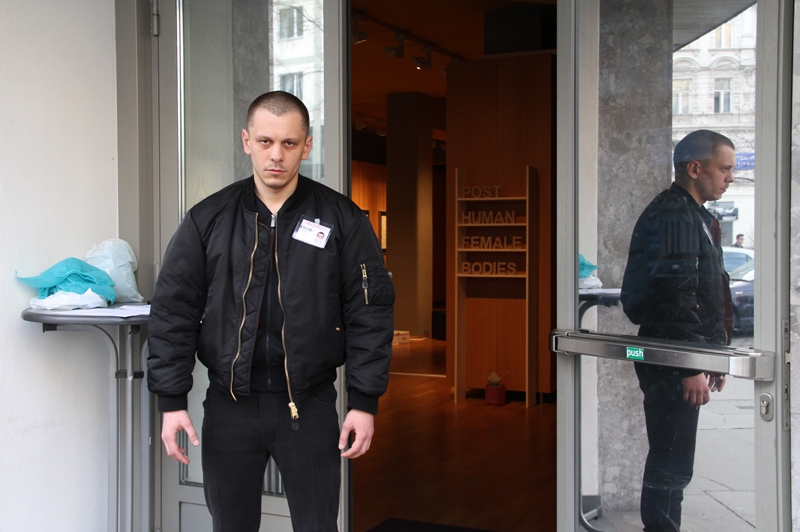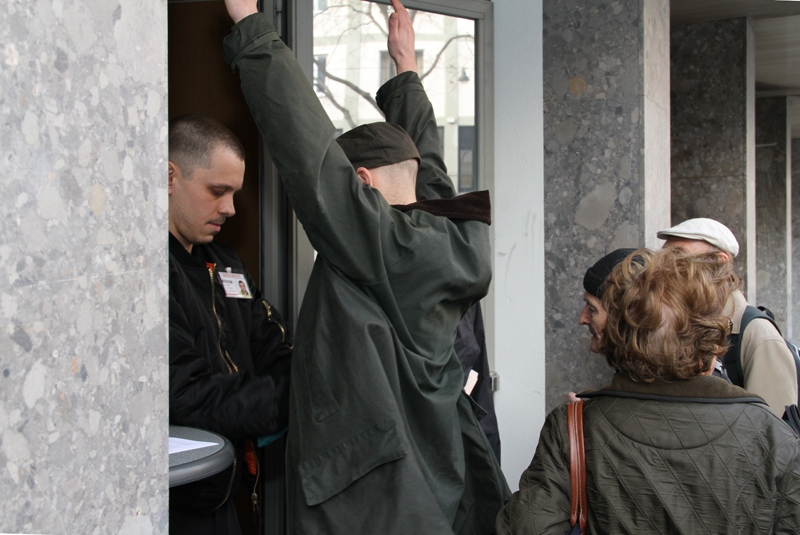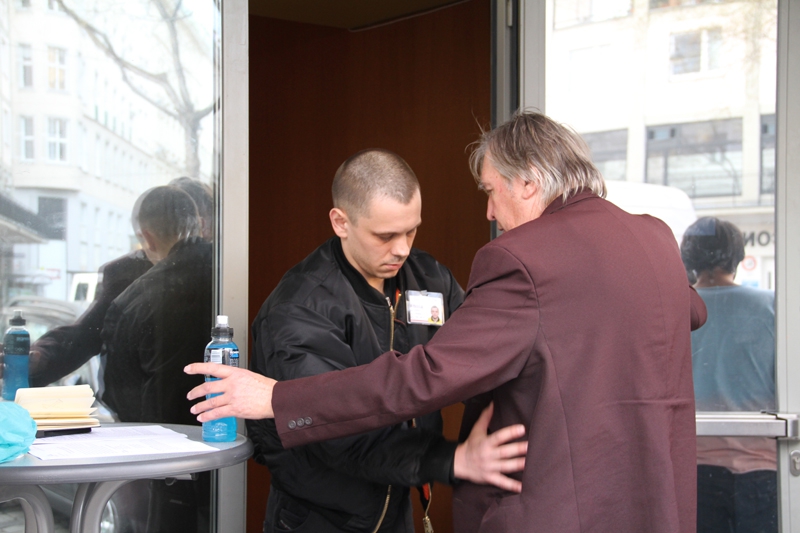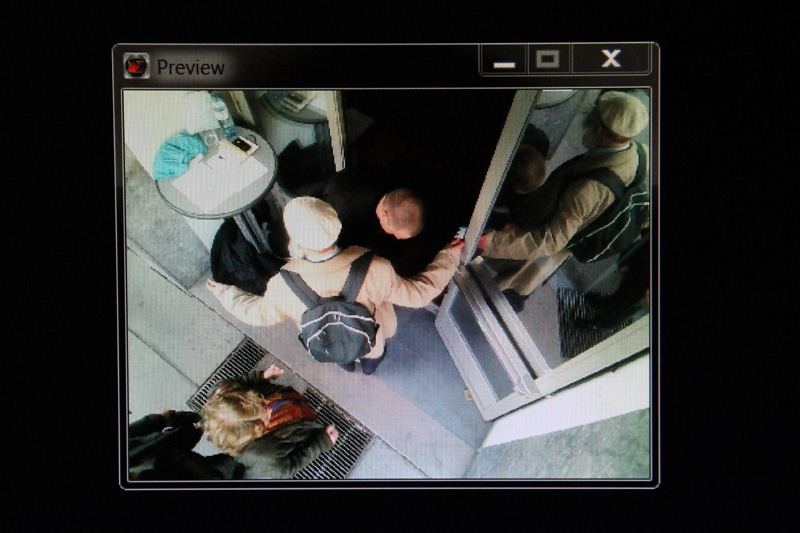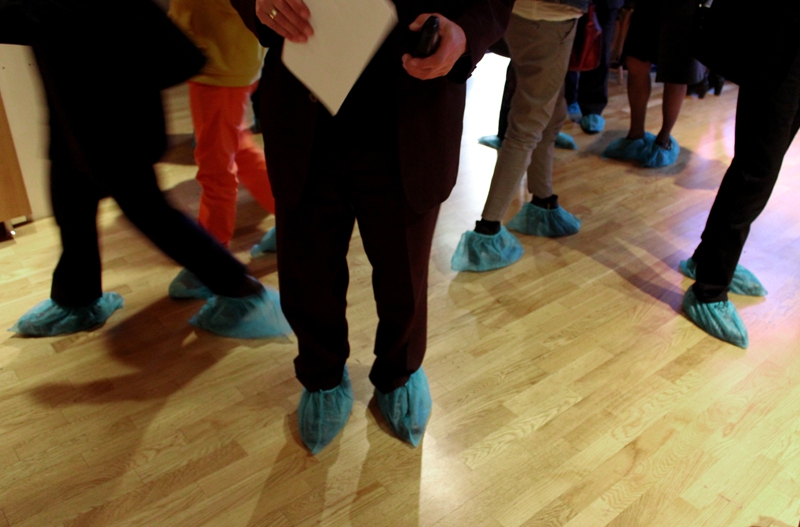Attention mode
Jedno od prvih direktnih iskustava ako živite ili radite u Beču jeste »jugo« iskustvo koje je i par decenija nakon što više ne postoji, nadživelo Jugoslaviju. Da li je u pitanju identitet ili imidž? Ipak, (ako je verovati podacima objavljenim na internetu), 2014. u Beču živi oko 300.000 tzv. Jugoslovena (od oko 1.700.000 stanovnika glavog grada Austrije) čija se integracija svodi na reprodukciju jeftine radne snage, koja paradoksalno, u najvećem broju slučajeva čuva »demokratski sistem« iz kojeg su zvanično, pa skoro isključeni. Međutim, da je ideja »jugoslovenstva« preživela u Austriji, govori i činjenica da kada neko od ljudi koji rade na ulazima kao obezbeđenje čuje da govorite prepoznatljivim jezikom, ulazite bez ikakve procedure provere i čekanja.
Marko Tirnanić je tokom boravka u Beču, preuzeo na jedan dan ulogu ovih »bitnih struktura društva«, prilagođavajući svoj izgled stereotipnom izgledu »ljudi na vratima«, šišajući se i oblačeći odeću tipičnu za obezbeđenje. Bez obzira na prethodno iskustvo slobodnog ulaska u galerijski prostor Ministarstva kulture Republike Austrije, ovoga puta posetioci su bez pogovora pristajali da nepoznati čovek (umetnik) proveri sadržaj njihovih ličnih stvari, istovremeno obuvajući bez ikakvog prethodnog uputstva ili naredbe jednokratne navlake za obuću koje su stajale u kutiji ispred galerije. Čovek je izgledao toliko uverljivo da je u jednom trenutku na otvaranju grupne izložbe savremene umetnosti u Beču, šetala masa u nazuvcima duboko verujući da je to normalna procedura i nove mere bezbednosti. Međutim, performans zapravo počinje u trenutku kada posetioci na samom kraju izložbe (ili izlasku iz galerijskog prostora) vide na ekranu direktan snimak sa ulaza, shvatajući da je reč o umetničkom činu u kojem su nesvesno učestvovali. Kroz isti umetnik zapravo razotkriva vezu između konstantne paranoje, granica prostora slobode i lične odgovornosti. A to je kontekst sa kojim se svakodnevno srećemo, samo se naša pažnja na isti (attention) razlikuje u odnosu na obim, trajanje, fluktuaciju i intenzitet ograničenja sredine u kojoj živimo. Namerni odabir galerijskog prostora za izvođenje performansa ne želi da zaštiti isti, već ga takođe podvrgne kritičkom preispitivanju sopstvene pozicije tj. dometa i ograničenja institucije i onih koji te institucije čine. Da li je tačno da se i taj poslednji prostor slobode pretvorio u »nemesto« (Ože) na kojem je zajednički život samo proizvod unapred određenih pravila koja se bez pogovora poštuju?
Zorana Đaković Minniti
-----------------
Attention mode
One of the first direct experiences, if you live and work in Vienna is the »yugo« experience, that outlived Yugoslavia, few decades after its dissapearance. Is it the identity or image? If one trusts the data published on the internet, in 2014 there are nearly 300.000 so called Yugoslavs – Yugos out of 1.700.000 inhabitants of the Austrian capital city. Their integration is a mere reproduction of cheap labor work, that is, paradoxically in many cases protecting the »democratic system« from which they are nearly excluded. However, one of the proofs that the idea of »Yugoslavs - Yugos« survived in Austria is the fact that, if someone from the security hears you speak one of the languages from ex Yugoslavia, you will enter any venue without due procedure, checks or waiting in a line.
Marko Tirnanić has, during his stay in Vienna, taken the role of one of those »important structures of the society« adjusting his apperance to stereotipical looks of security personnel and »doorman« by having a specific short haircut and wearing the typical. Although they had previous experience of free entrance to the gallery of Ministry of Culture of the Republic of Austria, this time visitors are complying to an unknown man (artist) checking their belongings, pockets, personal bags. At the same time, without any prior order or explanation, visitors are putting surgery caps, that were in a box in front of the gallery, on their shoes.
The artist appeared to be so convincing that at one moment, at the oppening of a group exhibition of contemporary art, all visitors walked in shoes covered by sugery caps, deeply convinced that such act is the regular procedure and new safety measure. However, the performance actually begins when the visitors at the very end of the exhibition, or when exiting the gallery space, spot on a screen live broadcast from the entrance, thus realising that it is a work of art in which they, unintentionally participated in.
Through this work, the artist is actually unveiling the relationship between constant paranoya, limits of personal freedoms and responsabilities. This context is daily encountered by all of us, only our attention to it differs with regards to scope, lenght, fluctuation and intensity of limits and constraints of the living environment. By intentionaly choosing gallery space for this performance, the artist does not want to protect it, but rather to expose it to critical rethinking of his own position, reach and limits of the institution. Is it true that even this last piece of free space and liberty has become »non-place« (Augé) whereby the common life is only a product of predetermined unconditionally respected rules?
Zorana Đaković Minniti
Rad je izvodjen u:
Galeriji Ministarstva kulture Austrije, Beč, Austrija, mart 2014.
Bivšem Kulturnom centru Čehoslovačke, Berlin, Nemačka, decembar 2014.
The work was performed in:
The Gallery of the Ministry of Culture of Austria, Vienna, Austria, March 2014
The ex Cultural Center of Czechoslovakia, Berlin, Germany, December 2014
